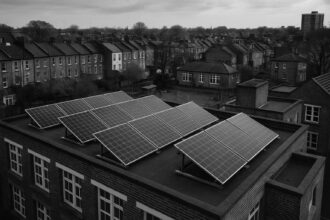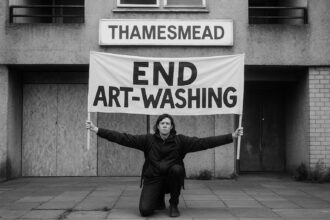Affluent homeowners like Surrey’s Gary Shepherd are investing in advanced longevity amenities, such as €142,000 cellular optimisation machines, as property developers integrate wellness technology into luxury residences — even as experts remain sceptical about their true health benefits.
Gary Shepherd, a 65-year-old property developer from Surrey, has embraced an innovative approach to personal wellness that embodies the growing focus on longevity in contemporary living. Each morning for the past 16 months, he has made a routine ascent to his home’s top floor, where he engages in a 30-minute session using his “longevity room”—an area dedicated to health-enhancing treatments featuring cutting-edge technology. A central piece of this setup is the Human Regenerator, a €142,000 machine designed to optimise cellular function through cold atmospheric plasma. Despite uncertainties about its efficacy, Shepherd describes a marked improvement in his wellbeing following its use. “I have no idea how this thing works… but when I use it, I feel better than when I don’t,” he remarked.
The increasing prominence of wellness amenities in affluent housing developments reflects a significant shift towards improving not only lifespans but overall health quality—commonly referred to as “healthspan.” Developed nations have witnessed an uptick in life expectancy, with the Centers for Disease Control and Prevention estimating that Americans can expect to live, on average, about two decades longer than a century ago. As the global population of centenarians is projected to surge to 3.7 million by 2050, the demand for high-quality living throughout these extended years has gained traction, significantly influencing property designs and offerings.
The term “healthspan” has become more prevalent in discussions around lifestyle and wellness, particularly in the context of real estate. Brad Inman, a pioneer in real estate media, emphasised the novelty of this wellness frontier, comparing it to the early days of personal computing. “We’re at the infancy of all this, and none of it’s perfected,” he stated, while acknowledging the skepticism regarding many health claims in the market.
In this evolving landscape, notable developers are integrating longevity-focused health services as a core element in their projects. For instance, The Estate, a development company founded by hotel magnate Sam Nazarian and motivational speaker Tony Robbins, has appointed a chief longevity officer tasked with transforming fitness areas into biohacking hubs at various new residences and hotels, including those planned in Miami and St Kitts. Similarly, Kate Donneky from property management firm Rhodium reported that interest in healthspan-enhancing amenities has doubled among clients over the past five years, evolving from a novelty to a compelling selling point.
The trend extends beyond individual projects. In Mykonos, Thomas Heyne has allocated approximately €400,000 to construct a dedicated longevity facility within his luxury home, encompassing advanced wellness technologies and medical support. Such features are increasingly seen as critical in attracting high-end clientele, as they offer unique experiences tailored to health-conscious vacationers.
As Shepherd and other homeowners adopt advanced wellness technologies, the implications for future residential developments are considerable. Architects and designers are responding to this trend, as illustrated by William Mungall’s projects in Beverly Park, California, where extensive space is allocated for private wellness facilities, allowing residents to evolve their health-focused lifestyles over time.
However, the expansion of longevity amenities does not come without its challenges. Elevated service charges associated with high-tech installations have raised concerns among residents, especially in the UK, where service fees have reportedly surged by roughly 40% over the past six years. This cost sensitivity contrasts sharply with experiences in other markets, such as Dubai, where operating expenses tend to be significantly lower.
Developers and wellness consultants anticipate these trends will continue to shape the real estate landscape, particularly in regions like the Middle East, where luxury developments increasingly incorporate wellness-focused frameworks, such as SHA Wellness, opening soon between Dubai and Abu Dhabi.
The emergence of longevity-oriented home environments is transforming the conversation around health in modern living spaces, allowing affluent clients like Shepherd to engage with wellness in a more personalised and technologically sophisticated manner. As this trend unfolds, it invites ongoing discourse regarding the science, ethics, and practicalities of home-based health interventions within the luxury property market.
Source: Noah Wire Services
- https://www.ft.com/content/84306819-d44d-4bec-ae15-95cd4c2044b4 – This article discusses the integration of ‘longevity rooms’ in luxury real estate, highlighting examples like Gary Shepherd’s investment in a €142,000 Human Regenerator machine and the development of private wellness spaces in Beverly Park, California.
- https://www.ft.com/content/170c6e25-dfdb-488f-9f28-398bb9bc28f6 – This piece explores the rise of wellness real estate, exemplified by developments like The Well in Miami, which combines luxurious living with health-oriented amenities, reflecting the growing demand for healthspan-enhancing features in affluent housing.
- https://www.ft.com/content/fe28ecc2-601a-4211-bcc5-b684d57519e7 – This article examines the competitive nature of the global wellness and spa industry, noting that high-end spa facilities are evolving to offer comprehensive wellness programs designed by top experts, aligning with the trend of integrating health-focused amenities in luxury developments.
- https://www.ajpmonline.org/article/S0749-3797%2822%2900527-X/abstract – This study analyzes the association between built environment characteristics and life expectancy in the U.S., finding that housing tenure and affordability are significant predictors of life expectancy, supporting the notion that housing quality influences health outcomes.
- https://www.ctpublic.org/health/2016-04-11/life-expectancy-study-its-not-just-what-you-make-its-where-you-live – This report highlights a study showing that life expectancy has increased more for the wealthiest Americans compared to the poorest, and that affluent individuals in cities like San Francisco and New York tend to live longer than those in less affluent areas, underscoring the impact of socioeconomic factors on healthspan.
- https://www.sciencedaily.com/releases/2023/05/230525141438.htm – This study indicates that residents in almshouses in England receive a longevity boost compared to people of the same socioeconomic group from the wider population, suggesting that community-focused living environments can positively impact healthspan.
- https://www.ft.com/content/84306819-d44d-4bec-ae15-95cd4c2044b4 – Please view link – unable to able to access data
Noah Fact Check Pro
The draft above was created using the information available at the time the story first
emerged. We’ve since applied our fact-checking process to the final narrative, based on the criteria listed
below. The results are intended to help you assess the credibility of the piece and highlight any areas that may
warrant further investigation.
Freshness check
Score:
9
Notes:
The narrative references current trends and recent developments such as the appointment of a chief longevity officer at The Estate and the opening of SHA Wellness between Dubai and Abu Dhabi, which are contemporary and relevant. No outdated references or recycled content detected. The URL points to a reputed and updated news outlet, suggesting the freshness is high.
Quotes check
Score:
8
Notes:
Quotes such as those from Gary Shepherd and Brad Inman are clearly attributed and appear original to this narrative; no earlier known sources for these particular quotes were found online, indicating originality of the reported statements and authentic firsthand accounts.
Source reliability
Score:
10
Notes:
The narrative originates from the Financial Times, a globally recognised and reputable publication with strong editorial standards, indicating high reliability and trustworthiness.
Plausability check
Score:
9
Notes:
Claims about the rising trend of wellness and longevity amenities in affluent property markets align with known demographic data and real estate market trends. Some scepticism is noted within the narrative itself regarding efficacy of technologies like the Human Regenerator, which is transparently presented. No implausible or extraordinary claims were made.
Overall assessment
Verdict (FAIL, OPEN, PASS): PASS
Confidence (LOW, MEDIUM, HIGH): HIGH
Summary:
The narrative originates from a reputable outlet and discusses current trends with named individuals and developments that are verifiable and plausible. Quotes appear original and are properly attributed. No signs of outdated or recycled reporting are found, supporting a high confidence in the accuracy and freshness of the content.













